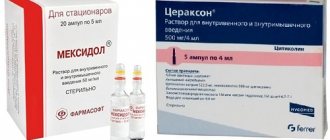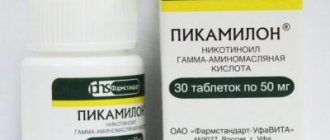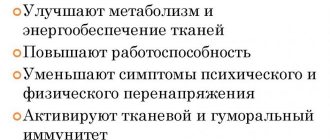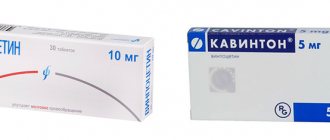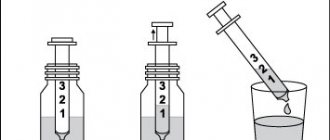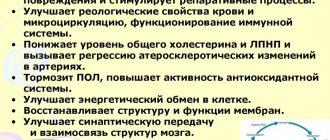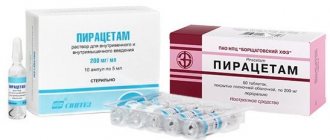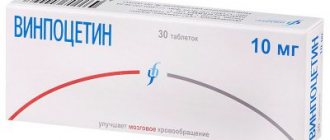Prohibited during pregnancy
Prohibited during breastfeeding
Not suitable for children
Can be taken by older people
Ceraxon is a nootropic drug with a psychostimulating effect. The medication is prepared in the form of solutions for oral and parenteral use. The active ingredient in the drug is citicoline. If you are allergic to citicoline, the doctor prescribes analogues of the drug Ceraxon.
Packaging of the drug Ceraxon
This medication is used for disorders of the blood supply to the brain of neurological, inflammatory and vascular etiology. Ceraxon is also used as part of the emergency treatment of cerebral ischemia and stroke and in the post-stroke period.
Ceraxon is effective in the treatment of brain injuries, as well as strokes and vascular diseases of the brain.
Ceraxon is not used for treatment of the following conditions:
- allergy to the medicinal composition;
- vagotonia;
- hemorrhagic stroke;
- intolerance to fructose;
- women during lactation.
Ceraxon is prescribed with caution to women during pregnancy (except the 1st trimester).
For ischemic stroke, it is necessary to begin therapy from the first hours of illness. The doctor determines the dosage and frequency of administration of the medicine personally. As a rule, 10 ml of medication is administered twice a day.
Side effects:
- blood pressure fluctuations;
- dizziness and headaches;
- vertigo and hallucinations;
- dyspepsia;
- allergic reactions.
pharmachologic effect
Manufacturer: Ferrer International, Spain
Release form: oral solution, injection solution
Active ingredient: citicoline
Synonyms: Noocil, Recognan, Naypilept, Encetron
The effect of the drug is due to the substance citicoline, which is a natural endogenous compound. The product has a wide spectrum of action:
- restores damaged brain cell walls;
- prevents cell death;
- reduces the volume of affected brain tissue;
- accelerates recovery after traumatic brain injury;
- improves attention and memory.
Once in the body, citicoline is quickly absorbed, reaches the brain cells and is integrated into them.
Purpose of nootropics
Due to their composition, all three drugs are suitable for treating lesions of the nervous system. In the acute period of a stroke, nootropic drugs help keep the nervous tissue alive until the blood supply is normalized, and in case of disturbances in the thought process, they restore a person’s activity, reducing his dependence on the help of others. Common indications for all drugs include:
- ischemic stroke in the acute period - nootropics are given with other medications;
- recovery after stroke;
- traumatic brain injury;
- disorders of behavior, memory, attention: including in diseases of the brain.
Advertising:
For the treatment of older people, drugs are prescribed in the case of senile dementia—decreased memory, level of thinking, and speech. They try not to give such drugs to children: the necessary studies have not been carried out, so taking medications is limited until the age of 18. The same applies to pregnant women: nootropics are prescribed to women only for serious indications, and nursing mothers are advised to wean their child off the breast during treatment. In animal experiments, however, drugs based on citicoline have proven their safety.
Probably every person has experienced a sore throat at least once in their life. In the pharmacy you can find many remedies to treat the symptom, one of which is Lugol's drug. Read more in the article: “how to gargle with Lugol.”
Ceraxon - instructions for use
The dosage regimen and medication regimen are calculated based on the form of release, the condition and age of the patient.
In the acute period of stroke or TBI, the drug is administered intravenously at 1000 mg twice a day for 3–5 days. Then 1 sachet or 10 ml 2 times a day. The course of treatment is at least 1.5 months.
During recovery, the dosage of Ceraxon is 500-2000 mg per day, and the duration of therapy is set individually.
How to take Ceraxon: before or after meals
According to the instructions for use, Ceraxon is taken between or during meals. If necessary, the solution is diluted in ½ glass of water.
Cerakson's analogs
The modern pharmaceutical market offers a wide range of nootropic drugs analogues of Ceraxon based on the active substance or mechanism of action in tablets, solution for injection and oral administration. Medicines may differ in composition, action and dosage regimen.
List of Ceraxon analogues with prices
| Name of analogue | Manufacturer country | Release form | Average cost in rubles | ||
| Cerakson | Spain | bottle | 690 | ||
| sachet | 1490 | ||||
| ampoules | 680-1150 | ||||
| Actovegin | Russia | pills | 1530 | ||
| ampoules | 620-1580 | ||||
| Cereton | Russia | capsules | 570 | ||
| ampoules | 380-580 | ||||
| Cavinton | Russia | pills | 110-210 | ||
| ampoules | 240 | ||||
| Piracetam | Russia | pills | 60-140 | ||
| ampoules | 100 | ||||
| Nootropil | France | pills | 258 | ||
| bottle | 323 | ||||
| Fezam | Serbia | capsules | 310 | ||
| Pantogam | Russia | syrup | 420 | ||
| pills | 440-670 | ||||
| Picamilon | Russia | pills | 117 | ||
| ampoules | 150 | ||||
| Cortexin | Russia | bottles | 1400 | ||
| Cerepro | Russia | capsules | 650-960 | ||
| ampoules | 380-520 | ||||
| Mexidol | Russia | pills | 270-500 | ||
| ampoules | 460-830 | ||||
| Recognan | Spain | bottle | 420 | ||
| sachet | 1250 | ||||
| ampoules | 580-900 | ||||
| Gliatilin | Italy | bottle | 725 | ||
| capsules | 720-2530 | ||||
| ampoules | 590 | ||||
| Cerebrolysin | Germany | ampoules | 1045-2900 | ||
| Cereton | Russia | ampoules | 380-570 | ||
| capsules | 560-1500 | ||||
| Cytoflavin | Russia | ampoules | 620-1060 | ||
| pills | 450-680 | ||||
| Encephabol | Austria | bottle | 1030 | ||
| pills | 915 | ||||
There is often a question about what can replace Ceraxon for an adult or which drug is better. All ambiguities associated with the choice of medication should be resolved by the attending physician.
Prices of Citicoline and its analogues
The cost of the medicine depends on many factors: manufacturer, quantity, release form, dosage. The average cost of Citicoline in syrup is 710 rubles (30 ml), and in solution form – 1130 rubles. If the patient is not satisfied with the price of the drug, you can choose an analogue at a more affordable price, after consulting with your doctor.
Substitutes may have the same chemical formula or principle of action.
| Name of medicine | Dosage/quantity | Price (in rubles) |
| Recognan | 100 ml 30 ml 4 ml No. 5 100 ml 10 pcs. | 406 544 1283 |
| Ceresil | 125 ml 5 amp. 250 ml 5 amp. | 411 836 |
| Naypilept | 100 ml 30 ml 250 ml No. 5 | 447 1168 |
| Cerakson | 4 ml No. 5 100 ml 30 ml (syrup) 100 ml 10 sachets | 671 704 1565 |
[compare name=`Cerakson|Neypilept|Recognan|Ceresil|Somazina|Cavinton|Phesam|Vinpotropil|Aminalon`]
Analogs, like the original, are available with a prescription.
See also:
TOP 6 cheap Phezam analogues - structural substitutes for the drug
Ceraxon or Cortexin - which is better for the elderly
Manufacturer: GEROPHARM LLC, Russian Federation
Release form: lyophilisate for preparing a solution for intramuscular administration
Active ingredient: polypeptides of the cerebral cortex of cattle
Synonyms: Cellex
Analog of Ceraxon - Cortexin injections. The medication has a noopropyl and antioxidant effect, improves metabolism in nerve cells and protects them from toxic effects. Cortexin is indicated for cerebrovascular accidents, encephalopathy, head injury, cerebral palsy, and developmental delay in children.
The analogue is administered intramuscularly 1–2 times a day, after dissolving the contents of the bottle.
Cortexin and Ceraxon have different compositions, but similar action and effectiveness, which is confirmed by numerous reviews. Both drugs can be used in older people without dose adjustment.
Differences and Benefits of Nootropics
Cereton, Recognan and Ceraxon are nootropics with the ability to accelerate the restoration of neuronal membranes and the production of the transmitter acetylcholine. Only one of them - Ceraxon - is an original drug with all the necessary studies and a high chance of being better than generics. Recognan is a cheap substitute with a different effectiveness, and Cereton reproduces the composition of the original Gliatilin. The drugs are prescribed in the form of solutions for oral administration or injection. Cereton is also available in capsules.
Indications for nootropics include acute brain damage due to stroke and trauma, as well as the recovery period and age-related brain disorders. All medications rarely cause side effects, but are not recommended for children. Cortexin injections based on polypeptides from the cerebral cortex of cattle can help in this case.
Cerakson or Mexidol - which is better for blood vessels, what is the difference
Manufacturer: ZiO-Zdorovye CJSC, Russian Federation
Release form: tablets, solution for intravenous and intramuscular administration
Active ingredient: ethylmethylhydroxypyridine succinate
Synonyms: Mexicor, Mexicofin, Neurox
Mexidol is a domestic analogue of Ceraxon, produced in ampoules and tablets. The drug has a wide spectrum of effects. The substance that is part of Mexidol has a nootropic, anticonvulsant effect, protects cells from destruction, and eliminates the lack of oxygen in the body.
Mexidol is prescribed for the following conditions:
- cerebral circulatory disorders;
- vegetative-vascular dystonia;
- consequences of concussion;
- stress and anxiety conditions;
- acute period of myocardial infarction;
- poisoning with alcohol, psychotropic drugs.
The dosage and regimen of taking the medication are selected by the doctor individually.
It is impossible to answer which medicine is best for blood vessels. Many years of practice have shown that Ceraxon and Mexidol are complementary drugs. Joint use is used by neurologists for TBI, strokes, and cerebrovascular accidents.
Contraindications and side effects
Ceraxon, Recognan and Cereton are relatively safe drugs. The products of their transformations in the body do not differ from those obtained by humans naturally. Citicoline is absorbed almost completely and is little excreted into the external environment, and an overdose has not been identified. Excessive intake of Cereton may cause nausea.
When treated with Cerakson or Recognan, it is better for patients to avoid driving or complex activities: the medicine may affect the reaction.
Hypersensitivity to the components of the medications may force you to interrupt treatment. Ceraxon and Recognan in the form of an oral solution are not prescribed for fructose intolerance, or in any form - in case of vagotonia.
Cereton should not be taken in case of acute hemorrhagic stroke - an outpouring of blood into the brain without injury.
There are fewer adverse reactions indicated for Cereton: they are associated with manifestations of allergies or nausea, which can be eliminated by reducing the dose. Citicoline-based drugs can also cause fever, tremors, headache or dizziness, diarrhea, sleep and appetite disturbances, hallucinations, changes in blood pressure and increased parasympathetic nervous system tone. All types of undesirable effects on the body are extremely rare, and usually the treatment goes smoothly.
Ceraxon or Cerepro - which is better?
Manufacturer: JSC Veropharm, Russian Federation
Release form: capsules, solution for intravenous and intramuscular administration
Active ingredient: choline alfoscerate
Synonyms: Noocholin, Nooprin, Cereton
Cerepro is a substitute for Ceracson in sachets and ampoules. The medicine has a nootropic effect, stimulates the production of an important compound, choline, in the brain, improves memory and attention. The analogue is used in the acute and recovery period for stroke and concussion, encephalopathy, dementia and senile dementia.
Treatment with Cerepro begins with injections, administering 1 ampoule per day for 10–14 days, and then taking 1 capsule. 3 times a day. The course of treatment is up to six months.
If we compare both drugs, Ceraxon is more effective, faster therapy and has many positive reviews from doctors.
Ceraxon or Recognan - which is better for the elderly
Manufacturer: SAG Manufacturing, Spain
Release form: solution for oral administration and injection
Active ingredient: citicoline
Synonyms: Ceraxon, Citicoline, Neuropol, Noocil
Recognan is an analogue of Ceraxon in terms of the active substance, produced in ampoules, bottles and sachets. Medicines have the same effects, indications and contraindications. Recognan is well tolerated in old age and does not require additional dose adjustment.
The advantages and disadvantages of the drugs are shown in the table.
| Name | pros | Minuses |
| Cerakson | clinical researches; fewer excipients; positive reviews from doctors. | high price |
| Recognan | new production technologies; affordable price. | Side effects are more common |
The treating neurologist should decide which medication to give preference.
Reviews from doctors and patients about the choice of Citicoline analogues
It is quite difficult to say with certainty which product is better. The choice of a suitable drug depends on many factors: characteristics of the disease, patient’s condition, personal preferences. With the help of reviews from doctors and people who have encountered the problem of selecting drugs, you can form a certain idea about them:
Lotsmanova O.O., pediatric neurologist: “Among analogues, Ceraxon (Citicoline) stands out for its convenient dosage form. It is quite difficult for kids to take pills, not to mention injections or IVs. It is much easier to drink a pleasant-tasting and aromatic syrup. The medicine has high rates of effectiveness. In my practice, I prescribe it to premature babies or after difficult births. The only drawback is the high cost."
Svetlana, 37 years old: “After a stroke in the hospital, my mother was prescribed Cerakson (iv). Symptoms included weakness in the left arm and leg. The drug eliminated sensory disorders. However, in addition to the positive effect, side effects appeared in the form of diarrhea. I also had to take antidiarrheal drugs. After some time it was replaced with Fezam. The form is more convenient and there were no side effects.”
Vladimir, 47 years old: “I went to the doctor with unpleasant symptoms. Severe and incessant dizziness developed. The pressure jumped. I was prescribed a 5-day course of Ceraxon. After a couple of days, anxiety, irritability and panic appeared. The pressure became even higher. I consulted the doctor again, and he replaced the drug with Aminalon. This effective and safe remedy helped me return to my normal lifestyle.”
Many patients prefer to use analogues, since the original often causes side effects. There are also people who took it and were satisfied with the results. It should be understood that the selection of drugs is a purely individual matter. Only with the help of a doctor can you create an optimal treatment regimen. Citicoline (Cerakson) and its substitutes are based on high-quality raw materials and are characterized by a mild effect.
Ceraxon or Cereton - which is better and more effective, what is the difference
Manufacturer: Sotex CJSC, Russian Federation
Release form: capsules, solution for intravenous and intramuscular administration
Active ingredient: choline alfoscerate
Synonyms: Cerepro, Gliatilin, Noocholin
Cereton is an analogue of Ceraxon, produced in solution for injection and capsules. The main component of the drug is choline alfoscerate. The substance exhibits a nootropic effect, promotes the production of choline, and enhances metabolic processes in the central nervous system. Cereton is used for traumatic brain injuries, strokes, disorders of consciousness, memory and disorientation.
During the recovery period after a concussion or stroke, take 800 mg in the morning and 400 mg in the afternoon. If dementia manifests itself, 1 capsule is prescribed 3 times a day.
The main advantages of the analogue are:
- more pronounced therapeutic effect;
- a small number of contraindications and adverse reactions;
- convenient form for reception.
Analogs by mode of action in tablets and ampoules
Cerakson's therapeutic effects are similar to medications that have different ingredients in their composition, but have one therapeutic direction - restoration of cerebral blood flow and brain function.
Bilobil Forte
Bilobil Forte is a herbal medicine based on a substrate from the leaves of Ginkgo Biloba. The herbal medicine blocks platelet adhesion, which significantly improves blood flow to the brain.
Bilobil is prescribed for a number of diseases:
- cognitive impairment due to stroke, brain injury, encephalopathy, age-related dementia;
- sleep rhythm disturbances and decreased intelligence;
- decreased attentiveness, concentration and memory;
- diabetic retinopathy;
- obliterating atherosclerosis and Raynaud's disease;
- decreased functioning of the visual and auditory organs.
The herbal medicine is not prescribed for allergies to plant components, as well as for children, nursing and pregnant women.
Take the drug one capsule three times a day. The duration of treatment depends on the pathology. On average it is 2-3 months.
Possible side effects:
- dizziness, fatigue, fainting;
- dyspepsia;
- itching of the skin, urticaria, rashes, hyperemia, Quincke's edema.
Vinpotropil
Vinpotropil is a complex nootropic with cerebroprotective effects. The medication dilates the membranes of the cerebral vessels, which ensures uninterrupted blood supply to all parts of the brain. The active ingredients in the medicine are vinpocetine and piracetam.
Instructions for taking the medicine:
- rehabilitation process after a stroke;
- parkinsonism;
- asthenia and intoxication;
- treatment of dizziness and migraine.
- encephalopathy of various etiologies;
- traumatic brain injuries;
- decreased cognitive abilities;
- withdrawal syndrome;
- Meniere's syndrome.
It is not recommended to take Vinpotropil in the following cases:
- allergies to medicinal ingredients;
- cardiac arrhythmia and ischemic heart disease;
- acute phase of hemorrhagic stroke;
- kidney and liver dysfunction;
- lactase deficiency and glucose malabsorption.
Vinpotropil is not used during lactation, pregnancy and childhood.
Prescribed with restrictions for the following pathologies in patients:
- disturbances in hemostasis and severe open or internal bleeding;
- hyperbilirubinemia and hepatitis;
- alcohol damage to liver cells;
- epileptic seizures.
The medication is administered using a dropper - 1-2 ampoules diluted in 500 ml of sodium chlorine. The speed of movement of the medicine through the dropper is 80 drops per minute. Therapy continues - from 10 days to 2 weeks.
Treatment regimen with capsules and tablets – 1 tablet (capsule) 2-3 times a day. The last dose of medication should be 4-5 hours before the patient goes to bed. Therapy can last from 2 weeks to 6 months. Dosages are reduced gradually so as not to provoke the development of withdrawal syndrome.
Vinpocetine and Vinpocetine Acree
Vinpocetine eliminates disturbances in cerebral blood flow and is used in neurology, psychiatry and cardiology. The active ingredient in the medicine is vinpocetine. The drug is produced in solution for injection and in tablets, and Vinpocetine Acre is only in tablets.
Medicine is prescribed for the following diseases:
- encephalopathy of various types;
- cerebral ischemic attacks;
- ischemic stroke and atherosclerosis of cerebral arteries;
- traumatic brain injuries;
- migraine;
- Meniere's syndrome;
- dementia and alcohol (medicine) intoxication.
It is not recommended to take the medicine for the following reasons:
- abnormal heart rhythm and ischemic heart disease;
- allergy to the components of the medication;
- acute phase of cerebral hemorrhage.
It is strictly prohibited to take during pregnancy and breastfeeding, as well as in childhood.
Despite the ban on the use of the drug in pediatrics, children from 3 months of age with cerebral hypoxia are prescribed Vinpocetine.
Tablets should be taken 1-2 tablets three times a day for 14-60 calendar days.
The injection solution is administered intravenously. Standard dosage for stroke treatment:
- 20 mg Vinpocetine + 500 ml infusion solution – for 2-3 days;
- from day 4 it is necessary to increase the dose to 1 mg and carry out the entire therapeutic course with this dosage;
- The duration of the course of therapy is 10-14 days.
If necessary, the doctor may prescribe pills.
Cavinton
Cavinton is a vasodilator that is effective in the treatment of cerebrovascular pathologies. The drug prevents the development of hypoxia, restores metabolism in brain cells and improves cognitive functions.
Cavinton is prescribed for the following conditions:
- ischemia and hypoxia of the brain;
- decreased memory, attention, concentration and intelligence;
- encephalopathy;
- vestibular disorders - dizziness, Meniere's disease and tinnitus;
- eye diseases due to vascular damage.
Medicine is not prescribed in the following situations:
- arrhythmia, ischemic heart disease, blood pressure fluctuations;
- kidney dysfunction;
- lactation period and pregnancy.
Take one tablet 3 times a day, after meals
The solution is administered only using a dropper - 20 mg of Cavinton + 500 ml of sodium chloride. Droppers are placed once a day; as the pathology progresses, the doctor may increase the number of injections.
Children are given the medicine by drip at the rate of 1 ampoule + 200 ml of solution for infusion with glucose.
Intravenous therapy continues for 2-3 weeks, then the patient is transferred to taking tablets.
The drug may cause side effects:
- fluctuations in blood pressure and heart rhythm disturbances;
- dizziness and drowsiness;
- dyspepsia;
- skin allergies and bronchospasms.
Cogitum
Cogitum is a medication based on acetylaminosuccinic acid, which is found in the central nervous system. Regulates the activity of the brain and central nervous system.
The drug is prescribed in the presence of the following conditions:
- insufficient blood supply to the brain;
- to restore cognitive functions;
- therapy of asthenic (alcohol syndrome).
The drug is not prescribed during pregnancy and lactation, as well as in case of allergies to components in the medicine and in children under 7 years of age.
The oral solution is prescribed to children 7-10 years old - 1 ampoule in the morning, 10-18 years old - 2 ampoules, and adult patients are recommended to take 2 ampoules in the morning and 1 ampoule before going to bed. Therapeutic course – 3-4 weeks. The drug, when used in therapeutic dosages, causes virtually no side effects.
Mexidol
Mexidol is a membrane protector for brain cells. This medication protects cell membranes from the effects of free radicals and has the following properties:
- antihypoxic;
- nootropic;
- antiepileptics;
- anxiolytic.
Mexidol is prescribed for the following diseases:
- impaired blood circulation in the brain;
- encephalopathy;
- vegetative-vascular dystonia;
- systemic sclerosis of cerebral arteries;
- withdrawal syndrome;
- pathologies that provoke brain hypoxia;
- anxiety disorders.
The medication is not prescribed for the following conditions:
- liver failure and kidney dysfunction;
- intolerance to the components of the drug.
The medicine is also not prescribed to children under 12 years of age, pregnant women and mothers whose children are breastfed. Prescribed with restrictions for sharp fluctuations in blood pressure - hypertension and hypotension.
Mexidol is used intravenously or intramuscularly. If cerebral blood flow is disrupted in the acute stage, the medication is administered using a dropper. The dosage for an acute attack of ischemia or stroke is 200-300 mg. After normalization of the patient’s condition, the patient is transferred to treatment with tablets.
Therapy begins with 100 mg three times a day, with progressive dosage increases. The allowed daily dosage is 800 mg.
Vegetative-vascular dystonia and encephalopathy are treated with intramuscular injections - 50-100 mg three times a day.
For dementia, drug and alcohol poisoning, a daily dosage of 300 mg is prescribed, divided into 3 tablet doses.
Side effects:
- dyspepsia, flatulence;
- sleep disturbance;
- headache;
- hives.
Nootropil
Nootropil is produced in the form of a solution for injections, capsules and tablets. The medicine contains piracetam as an active ingredient.
Nootropil is prescribed in the following cases:
- decreased memory and intelligence;
- dizziness and unsteadiness of gait;
- Alzheimer's disease;
- alcoholism;
- sickle cell anemia;
- myoclonus and post-stroke state.
Nootropil is not prescribed to patients with kidney failure, cerebral hemorrhage, when the body is sensitive to the composition of Nootropil, as well as during lactation and infants under 12 months.
The daily dosage of the medicine is divided into 2-3 doses. The dosage is determined depending on the pathology:
- dizziness therapy – 2400-4800 mg;
- Treatment of myoclonus begins with a dose of 7200 mg. The increase occurs by 4800 mg every 3 days. Therapeutic dosage – 24000 mg;
- treatment of dyslexia in children over 8 years of age – a dose of 3200 mg per day is required
Side effects:
- hallucinations, depression and apathy;
- overexcitement and irritability;
- epileptic seizures;
- dyspepsia;
- skin allergy.
Piracetam
Piracetam is produced in tablets, capsules and solution for injections. The active ingredient is piracetam. The medication is prescribed for the following conditions:
- cognitive impairment;
- brain injuries;
- atherosclerosis of cerebral arteries;
- impaired microcirculation of the brain;
- alcoholism;
- dementia;
- neurological pathologies or mental disorders.
Children are prescribed Piracetam for dyslexia (after 8 years) and for the treatment of sickle cell anemia (from 3 years).
It is prohibited to take Piracetam in treatment for the following conditions:
- renal failure;
- hemorrhagic stroke;
- allergy to components;
- the child's age is under 12 months;
- pregnancy and lactation.
For the treatment of cognitive impairment, a dosage of 4.8 g per day is used for 7 days. Maintenance therapy – 2.4 g.
Side effects:
- disturbances in the functioning of the central nervous system - lethargy, respiratory depression, depression;
- hives;
- dyspepsia.
Fenotropil
Phenotropil is a nootropic medication and is produced in tablets based on phenotropil.
Indications for the appointment of Phenotropil are:
- decreased mental and motor activity;
- chronic fatigue;
- memory loss and cognitive impairment;
- depression and causeless anxiety;
- impaired blood flow in the brain;
- convulsions;
- schizophrenia;
- alcoholism;
- sleep disorders.
The drug has some restrictions for use:
- hypersensitivity to components;
- pregnancy and breastfeeding of a newborn.
The standard therapeutic regimen is 200-300 mg twice a day. It is permissible to take no more than 750 mg per day. The last dose of medication should be at 15:00.
Adverse reactions - dermatological allergies, blood pressure fluctuations, emotional lability (overexcitement, aggression, tearfulness).
Cellex
Cellex is produced in the form of a solution that is administered subcutaneously. The drug activates synaptogenesis and neuroprotection, and also restores brain cells and improves their reparative potential. The drug is prescribed for cerebrovascular pathologies - impaired blood flow in the brain at different phases of the disease.
It is prohibited to prescribe medicine for the following conditions:
- epilepsy;
- affective insanity;
- delirium;
- up to 18 years old
- lactation and pregnancy.
The medicine is administered subcutaneously once a day for 10 days at a dosage of 0.1-0.2 mg.
Negative effects:
- skin hyperemia and urticaria;
- insomnia or drowsiness;
- headache.
See also:
TOP 12 cheap analogues of Spazmalgon - drug substitutes for the active substance
Ceraxon or Cerebrolysin - which is better and more effective?
Manufacturer: EVER Pharma Jena, Germany
Release form: injection solution
Active ingredient: peptide complex
Cerebrolysin is an imported analogue of Ceraxon for oral administration and injection. The medication contains active neuropeptides that have a nootropic effect, protect nerve cells from damage, and improve metabolic processes in them. Cerebrolysin improves consciousness and memory.
The medication is used for traumatic brain injuries, strokes, dementia, developmental delays, memory and attention disorders in children, and Alzheimer's disease.
The dosage regimen and duration of treatment depend on the patient's condition. No additional dose adjustment is required for elderly patients.
A comparison of medications is shown in the table.
| Name | pros | Minuses |
| Cerakson | various forms of release; cheapness; | admission from 18 years of age; |
| Cerebrolysin | wide spectrum of action; use in children; | there is no oral form; high cost; |
Nervous system protection
Brain damage during a stroke, deterioration of memory and thinking due to diseases of the nervous system and old age reduce the quality of life and its duration. The situation is complicated by the prevalence of disorders of the blood supply to the brain - strokes are steadily taking their place among the leading causes of death. You can help the brain recover by providing it with building materials for cell membranes and mediators, as well as by protecting cells from oxidative processes and working to improve blood circulation. Good results are shown by drugs with precursors of substances needed by the central nervous system. While Cerakson and Recognan contain the same active ingredient, Cereton is more different from its group neighbors, but acts in a similar way.
Citicoline or Ceraxon - which is better?
Manufacturer: Ozon LLC, Russian Federation
Release form: solution for intravenous and intramuscular administration
Active ingredient: citicoline
Synonyms: Ceraxon, Noocil
Citicoline is a Russian analogue of Ceraxon 1000 mg in a sachet, which is available in ampoules. The drugs have the same active ingredient, mechanism of action, indications and contraindications for use.
Citicoline is administered intravenously or intramuscularly during the acute and recovery periods for traumatic brain injuries, strokes, and cognitive and behavioral disorders.
The main differences between the domestic analogue include:
- lack of oral form;
- reasonable price.
If the question is what is cheaper to replace Ceraxon in a sachet, then after consulting a doctor, preference is given to Citicoline.
Which drug is better to choose
One drug can completely replace another; they have absolutely the same effectiveness, dosage, duration of therapy and features of administration. If we consider the efficiency-price ratio, then the domestic drug Recognan is preferable, but provided that the patient does not have a specific reaction to its composition.
Ceraxon is a third more expensive than its competitor with a “purer” composition with fewer auxiliary components. It is also available in tablet form, which may be more convenient for some groups of patients with mild circulatory disorders. Both drugs are prescribed only by a doctor, after analyzing the patient’s condition.
Medicine and healthComment
Ceraxon or Gliatilin - which is better?
Manufacturer: Italpharmaco, Italy
Release form: solution for injection, solution for oral administration, capsules
Active ingredient: choline alfoscerate
The imported analogue of Ceraxon is Gliatilin. The medication contains choline alfoscerate and has a nootropic effect, improves metabolism in nerve cells, and stimulates the formation of choline. The drug is used after stroke and TBI, for cognitive impairment and dementia, to improve attention and performance.
Gliatilin is taken orally, 1 capsule or 7 ml 2-3 times a day, and injections are administered at 1000 mg once.
The advantages of the analogue include:
- accelerated absorption;
- variety of release forms;
- convenient dosing;
- reception allowed while driving a car;
- numerous positive reviews from doctors.
In addition, Gliatilin has wider indications for use, so it is better to choose it for older people.
Substitutes for therapeutic effect
In some cases, medications are required that have a different active substance (for example, if you are intolerant), but have a similar therapeutic effect.
Vinpocetine
The action of a medicine based on vinpocetine is aimed at improving cerebral blood flow and metabolism, as well as normalizing blood viscosity. The spectrum of action of the product is very wide, in particular:
- stroke;
- TBI;
- cerebral atherosclerosis;
- encephalopathy;
- spasm of cerebral vessels;
- vascular dementia;
- motor and cognitive disorders;
- thrombosis of eye vessels, glaucoma, retinal changes;
- hearing impairments of various nature;
- vasovegetative disorders associated with menopause.
This medication is prohibited for use in the presence of heart problems - coronary artery disease, severe arrhythmia, as well as in children under 18 years of age; pregnant and breastfeeding women.
Piracetam
Piracetam, which is the basis of the drug of the same name, is a nootropic substance that is a cyclic derivative of gamma-aminobutyric acid (GABA). Its main effect is to improve connections between the hemispheres of the brain and synaptic transmission in neocortical structures, as well as improve cerebral blood flow. It is used for the symptomatic treatment of intellectual-mnestic disorders (if there is no diagnosis of dementia) and for myoclonus (involuntary muscle contractions).
Contraindications for its use are:
- intolerance to piracetam and pyrrolidone derivatives;
- hemorrhagic stroke;
- Huntington's chorea;
- severe chronic renal failure;
- age up to 3 years;
- severe hemorrhagic disorders.
Noobut
This is a psychostimulant and notropic drug based on phenibut. Available in the form of tablets for oral administration of 100 or 250 mg of the active ingredient. The main advantage is its mild action and lack of pronounced toxicity. It can be prescribed to children to treat stuttering, urinary incontinence, and nervous tics.
For adults, the medicine helps cope with insomnia, emotional lability, stress, nervousness, and asthenia. The drug is also prescribed to prevent motion sickness and to eliminate withdrawal symptoms.
Glycine
Glycine is an amino acid that is produced by the human body. To compensate for its deficiency, a synthesized analogue is used. When consuming the substance, there is an improvement in metabolism in the brain.
Glycine has antidepressant, antitoxic, antioxidant and sedative effects. It is prescribed to improve intellectual and thinking abilities, eliminate neuroses, sleep problems, and also as part of a comprehensive treatment of alcoholism.
Cortexin
A drug based on polypeptides from the cerebral cortex of cattle is classified as a neurostimulant. It is available in the form of a lyophilized powder, from which a solution for injection is prepared. The main actions are nootropic, neuroprotective, antioxidant.
Cortexin is prescribed as an adjuvant for:
- stroke and TBI;
- asthenia;
- encephalopathy;
- epilepsy;
- cerebral palsy;
- delayed speech and psychomotor development in children.
Ceraxon or Cytoflavin - which is better and more effective
Manufacturer: POLYSAN NTFF LLC, Russian Federation
Release form: tablets, solution for intravenous administration
Active ingredient: riboflavin, nicotinamide, inosine, succinic acid
Cytoflavin is an analogue of the drug Ceraxon, which can be purchased cheaper. The vitamins included in the drug improve metabolic processes in brain cells and improve cellular respiration. Cytoflavin exhibits antioxidant and antihypoxic effects.
It is impossible to say which is better, Cerakson or an analogue. Cytoflavin is used as part of complex therapy, including with Ceraxon, for ischemia, cerebral infarction, encephalopathy and other pathologies.
The regimen for taking Cytoflavin is as follows:
- 2 tablets twice a day with an interval of 10 hours;
- 10 ml intravenous drip is diluted in 100–200 ml of saline and administered 2 times a day with an interval of 8–10 hours.
The duration of treatment is 10–25 days.
Cavinton
Manufacturer: JSC GEDEON RICHTER-RUS, RF
Release form: tablets, concentrate for the preparation of solution for infusion
Active ingredient: vinpocetine
Cavinton is a Russian analogue of Ceraxon in tablets. Vinpocetine, which is part of the medication, improves metabolic processes in the brain, increases blood circulation and oxygen supply. Cavinton is prescribed for disorders of cerebral blood flow, dementia, hearing and vision impairment caused by vascular pathologies.
The analogue in tablet form is taken 5–10 mg 3 times a day for 30–90 days. And intravenous drip is administered once at a dosage of 25–50 mg.
